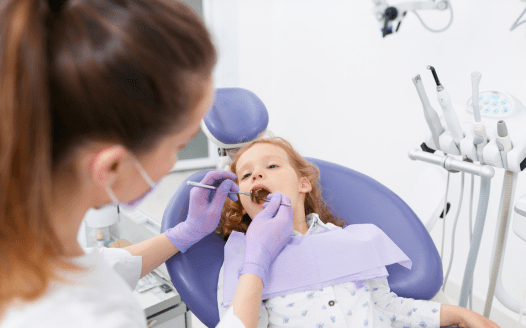Laterality of preschool children:
right-handed or left-handed?
At preschool age, children have sufficiently developed fine motor skills for it to become obvious whether they will be left- or right-handed. However, it is not always easy to tell.
What is laterality, how is it developed, divided and diagnosed?
Is left-handedness a disability?
How do you recognize crossed laterality?
On entry to school, laterality should be pronounced. The girl in the picture will probably be right-handed.

What is laterality
Laterality ( from lat. latus, lateris, n. – side, flank) means in a broader sense the right and left side. In the narrower sense, the term is used for the preference of a limb or sensory organ (hand, foot, eye, ear), and in the strictest sense to denote the dominant hand, i.e. right-handedness or left-handedness. . Laterality is manifested by a person’s preference for one of a pair of organs in particularly delicate tasks. When he cares about the result and thus needs to work as accurately, quickly and with the least fatigue.
Since laterality is related to the specialization of the cerebral hemispheres, laterality is one of the most specific human characteristics. In the brain, the developmentally youngest centers – hand motor and speech – are lateralized. The respective centers for these functions are located in close proximity. Speech centers are located in the left hemisphere in 90% of right-handed people and 70% of left-handed people.
Development of laterality
In general, laterality is divided into form and function.
-
- Shape laterality refers to the fact that the limbs, trunk and head and face are not completely symmetrical, i.e. they have a different shape.
- Functional laterality refers to the preference for one of a pair of organs to perform an activity. The more demanding the work a body part performs, the greater the difference in laterality. It is most noticeable in the hands, which is why we divide people into left-handed and right-handed..
Functional laterality of the hands is not immediately apparent from birth and is the result of individual development. The development of laterality can be observed in the child from about 1 year of age, as it is directly related to the structuring of the speech center in the right or left cerebral hemisphere. However, the prerequisites for laterality are innate. Already in the mother’s womb, the fetus prefers one thumb for sucking. The preferred hand in the prenatal period correlates with the dominant hand in adolescence. Left-handedness is partly hereditary. Therefore, when determining laterality, family history is taken – whether someone in the family is left-handed.
Children enter kindergarten with varying degrees of laterality. Very marked right- and left-handers will probably not be in doubt. Less well-defined right-handers are likely to conform to the majority. Children who have not yet decided which hand they prefer should be handled sensitively, slowly, without pressure, and given the opportunity to decide. Laterality in preschool children can still be variable. It is possible that some very undecided children will not make up their minds until just before starting school. It is helpful if, when practicing graphomotor skills, the child already knows which hand he or she prefers. Compulsory pre-school education for children from the age of 5 can also help the child to practice good graphomotor skills, including identifying the dominant hand. The last year of kindergarten also focuses on this issue.
How the laterality of the hand is divided
There are three types of laterality.
-
- Orthodoxy: 89% of the population
- Left-handedness: 10%
- Ambidexterity (i.e. undefined laterality): 1%.
Right-handedness and left-handedness have two more degrees of intensity. Marked, marked right-handedness and left-handedness and less marked right-handedness or left-handedness.
According to the relationship between the laterality of the hand and the eye we distinguish
-
- Laterality consonant (dominance of the right hand and right eye or left hand and left eye)
- Laterality indeterminate (different variants of distinct and indistinct dominance of the hand or eye)
- Laterality crossed (crossed dominance of right hand and left eye, left hand and right eye)
Why, when and how to recognize laterality in children
The reasons for detecting laterality are obvious. By the time a child starts school, he or she must have laterality clarified in order to begin writing practice. In fact, according to the dominant hand, writing and art utensils, seating arrangements, and the procedure for writing on paper and on the blackboard will vary to some extent. A vague laterality would confuse the child and he would not know what tools to choose.
Parents and kindergarten teachers can use their observation to assess laterality. This is sufficient for most children. The dominant hand is the hand that is more active, more dexterous, the hand that the child chooses first when offered to draw, the hand that scoops the soup, the hand that leads the movement e.g. when screwing, hammering, holding the thread when threading the needle. Although the assessment of laterality may seem simple, it should be approached with respect. If parents and nursery teachers are unsure, it is advisable to contact designated places, such as the educational and psychological counselling center.
 The dominant hand is the hand that leads the movement. The boy in red will probably be left-handed and the boy in blue right-handed. In preschool children, however, laterality is still variable.
The dominant hand is the hand that leads the movement. The boy in red will probably be left-handed and the boy in blue right-handed. In preschool children, however, laterality is still variable.Laterality test
Professionals competent to perform laterality tests, sometimes colloquially referred to as left-handedness tests, are a psychologist, a psychiatrist, a clinical speech therapist and a special educator. They use standardized tests to do this. If parents wish to consult and have a test carried out, they visit the educational and psychological counselling center. In addition, laterality is tested to determine school maturity during a check-up with a pediatrician at 5 and a half years. The result is recorded in the Health and Immunization Certificate for Children and Adolescents, which is the only official record of laterality. By this age, most children already “know” which hand is dominant. Further verification usually takes place at school enrolment. However, by law, the child does not have to be present at enrollment (especially during the pandemic, attendance was waived), so this verification does not have to occur.
Levity
If you come to the conclusion that the child is left-handed, this is no problem nowadays. Teachers know how to teach left-handed pupils and how to adapt the conditions for them. It shouldn’t be a problem in terms of future careers either. Although many tools are adapted to the majority right-handed population, left-handed pupils are increasingly being taken into account. Not only writing instruments and scissors, but also dental chairs and other equipment can be purchased for left-handed people. Thus, left-handed people are now quite commonly teaching at primary school level 1, practicing medicine and other fields.
 Nowadays, many instruments are adapted for left-handed users,
Nowadays, many instruments are adapted for left-handed users,e.g. dental chairs.
Left-handed reeducation
Definitely do not consider trying to “reteach” a left-handed person. This practice was common among today’s grandparents’ generation, but left-handed reteaching was banned in the Czech Republic in 1967. Because of how closely intertwined the fine motor centers of the hands and speech are, efforts to reteach can result in a speech disorder such as stuttering. Such a case is illustrated in the famous film The King’s Speech, in which the British monarch George VI overcomes his stammering, allegedly caused by being forced to use his right hand.
Crossed laterality
From a pedagogical-psychological point of view, crossed laterality means a different dominance of the hand and eye. It occurs when the child has a dominant left hand and right eye or, conversely, a dominant right hand and left eye. In both cases, the child may have slight difficulties in learning to read and write, as the stimuli from the eye to the brain, then transmitted to the hand, must travel a longer distance than in children with identical laterality, and errors are more likely to occur. A typical symptom in preschoolers is a reluctance to draw, difficulty imitating shapes, finding differences in shapes, distinguishing mirror-like shapes. In preschoolers we notice problems with right-left orientation, with letters b/d, s/z, which are similar, only mirror oriented. Problems resulting from crossed laterality can be alleviated by practicing visual perception, e.g. playing with blocks, identifying differences, putting together puzzles.
Clear laterality is one of the signs of school maturity. It is therefore important to pay attention to it in the preschool period. Parents should work with the nursery school to determine laterality or have a laterality test by a specialist, for example at an educational and psychological counselling center. Children should be approached sensitively and given the space to choose the ‘handier’ hand so that they develop well, regardless of whether they are left- or right-handed.
SOURCES:
JURAČKOVÁ, Lenka. Diagnostika laterality u dětí předškolního věku [online]. Olomouc, 2013 [cit. 2021-04-09]. Dostupné z: https://theses.cz/id/c0m235/. Bakalářská práce. Univerzita Palackého v Olomouci, Pedagogická fakulta. Vedoucí práce Mgr. Renata Mlčáková, Ph.D.
ŽÁKOVÁ, Ivana (2019): Lateralita, leváctví a specializované funkční oblasti mozku. Anthropologia integra, 10(2), 51–58. https://doi.org/10.5817/AI2019-2-51
www.levactvi.cz
www.jednoducheuceni.cz
www.novadida.cz
13. 11. 2023 | admin














